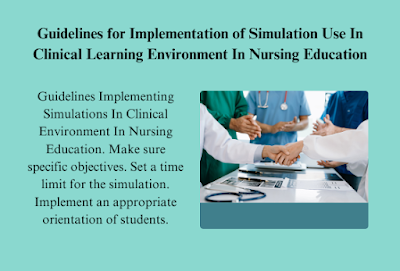The Guidelines for Implementation of Simulation Use In Clinical Learning Environment In Nursing Education. Nursing simulation labs recreate a clinical environment. This allows nursing students to safely practice nursing scenarios and hone their skills before applying them to real patients during clinical placements and in professional practice.1
The Guidelines for Implementation of Simulation Use In Clinical Learning Environment In Nursing Education
To effectively use simulations in nursing education, it is necessary to focus on developing and training simulation experts, conducting simulations efficiently, utilizing new technologies, and assessing learning outcomes. Design simulations with clear objectives, use a structured process such as the five-step simulation method, and ensure that nurses are trained in simulation technologies. Simulations should provide students with a safe and controlled environment in which to practice and refine their skills, mimic real-life scenarios, and bridge the gap between theory and practice.
Simulation Use In Clinical Learning
1. Define Clear Objectives
Ensure that specific objectives are established and aligned with the simulation’s purpose. Clearly define the goals for both students and facilitators. For instance, if the simulation focuses on managing an insulin-dependent patient, the scenario should be designed to address common issues and necessary problem-solving skills specific to that condition. Avoid including extraneous issues or co-morbidities that are not relevant to the simulation’s primary objectives.
2. Set Time Limits
Establish a clear time frame for both the simulation and the subsequent debriefing session. Adhere to this schedule to prevent scenarios from dragging on longer than intended. For example, if a simulation is set for 20 minutes, it should conclude within that period. If students do not meet the objectives, use the debriefing time to reflect on their experiences and the insights gained.
3. Orient Students to the Simulation Environment
Provide an effective orientation to the simulation labs to reduce students’ anxiety and familiarize them with the environment. Include a confidentiality agreement to create a safe space for discussions and a fiction contract to ensure students treat simulations as real clinical encounters. This preparation helps in mitigating initial fears and enhances the learning experience.
4. Assign Specific Roles
For undergraduate programs, assign roles to students in advance to organize the simulation experience efficiently. Roles could include nurse, observer, or family member. This pre-assignment helps in avoiding confusion and ensures that each student knows their responsibilities. In advanced practice programs, students may determine their roles, which can be a topic for discussion during post-simulation debriefing.
5. Avoid Interruptions
Allow students to problem-solve independently without interruptions. Facilitators should observe the simulation remotely through one-way mirrors or closed-circuit television to avoid influencing the scenario. Discuss observations, concerns, and problem-solving strategies during the debriefing session to ensure students receive feedback on their performance.
6. Limit the Number of Participants
Keep the number of students participating in the simulation manageable, typically between two and six, with additional observers or recorders if necessary. Clearly identify roles with name tags or appropriate clothing. This approach ensures that each participant is actively involved and that the simulation remains organized.
7. Match Simulations to Skill Levels
Design simulations that align with the learners’ current skill levels and cognitive abilities. Early simulations should match students’ didactic learning, using low- or medium-fidelity manikins and standardized patients for basic skills practice. As students progress, introduce more complex scenarios involving higher fidelity to challenge their critical thinking and collaboration skills.
8. Include Faculty Development
Incorporate faculty development into the planning process for simulations. Educators need training in conducting simulations and debriefing sessions to achieve desired learning outcomes. Ensure that all faculty members involved in simulations are well-versed in the simulation’s purpose and objectives. A clear, consistent approach to simulation and debriefing should be agreed upon, including a concept map to guide facilitators.
Conclusion
Implementing simulations in clinical learning environments enhances nursing education by providing practical, interactive experiences that bridge theory with real-world application. By following these guidelines, educators can create effective simulation scenarios that meet educational objectives, engage students, and prepare them for clinical practice.
Guidelines for Implementation of Simulation Use In Clinical Learning Environment In Nursing Education
Guidelines for Implementation of Simulation Use In Clinical Learning Environment In Nursing Education
Guidelines for Implementation of Simulation Use In Clinical Learning Environment In Nursing Education
Read More:
https://nurseseducator.com/didactic-and-dialectic-teaching-rationale-for-team-based-learning/
https://nurseseducator.com/high-fidelity-simulation-use-in-nursing-education/
First NCLEX Exam Center In Pakistan From Lahore (Mall of Lahore) to the Global Nursing
Categories of Journals: W, X, Y and Z Category Journal In Nursing Education
AI in Healthcare Content Creation: A Double-Edged Sword and Scary
Social Links:
https://www.facebook.com/nurseseducator/
https://www.instagram.com/nurseseducator/
https://www.pinterest.com/NursesEducator/
https://www.linkedin.com/in/nurseseducator/
https://www.researchgate.net/profile/Afza-Lal-Din
https://scholar.google.com/citations?hl=en&user=F0XY9vQAAAAJ

Fantastic stuff Many thanks.
casino en ligne
Regards, Ample postings.
meilleur casino en ligne
You revealed it fantastically!
casino en ligne France
You actually expressed this really well!
casino en ligne francais
Nicely put. Kudos.
casino en ligne
Effectively spoken genuinely. .
casino en ligne
Thank you! A lot of content.
casino en ligne
You made the point.
casino en ligne
You expressed that terrifically.
casino en ligne
Thank you! I like this!
casino en ligne